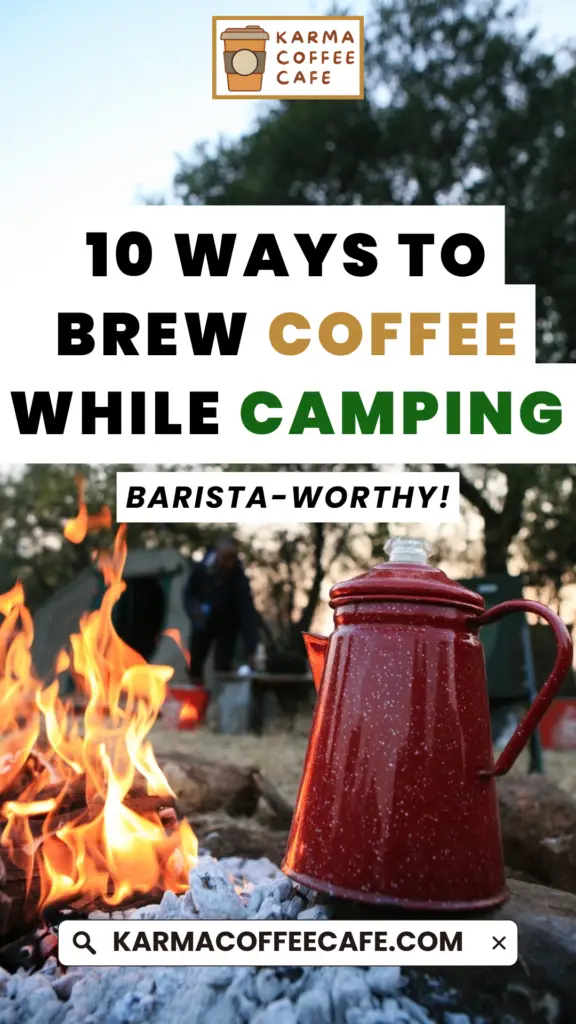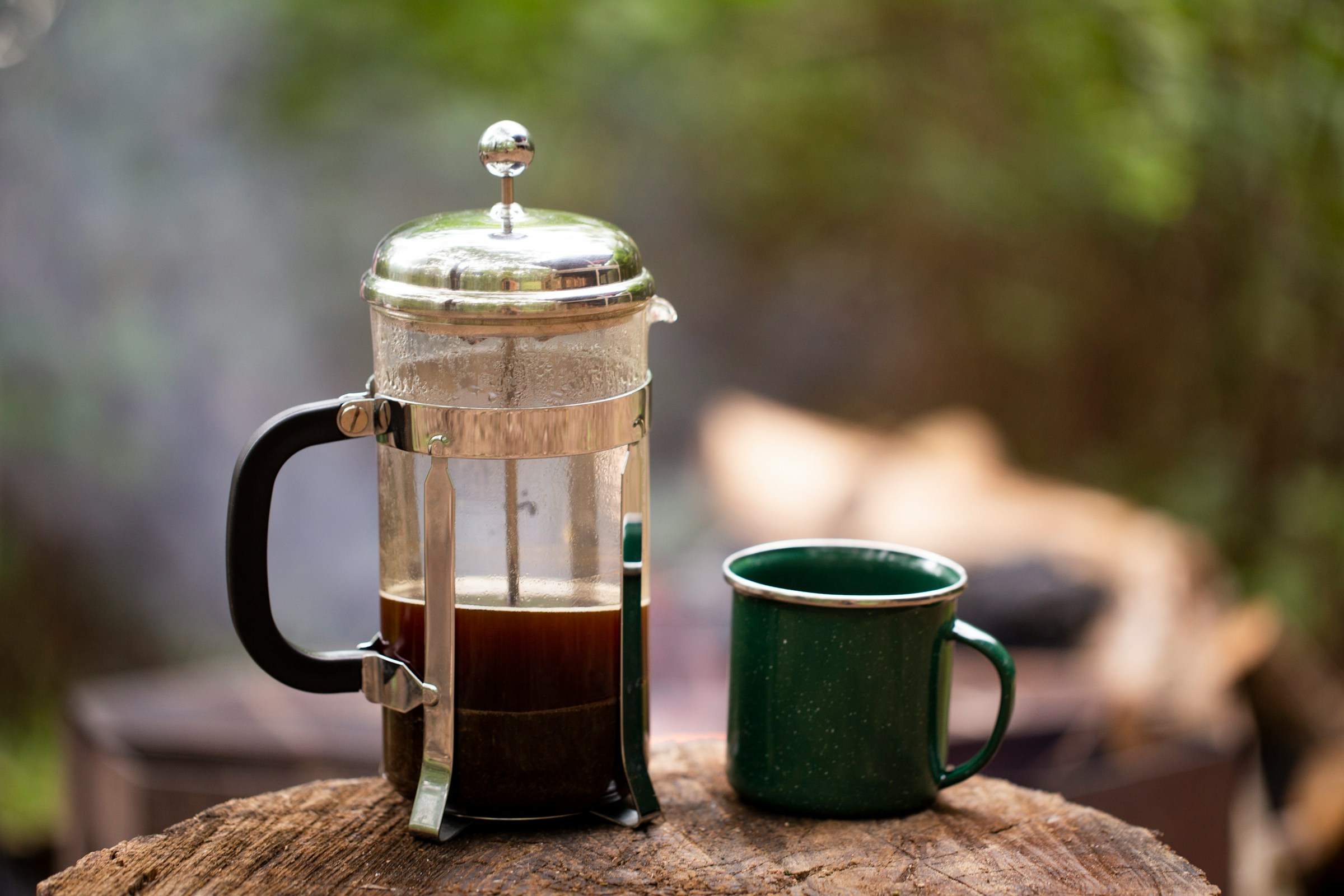There’s nothing quite like enjoying a fresh cup of coffee in the great outdoors.
Whether you’re waking up to the sounds of nature or relaxing after a long hike, brewing coffee while camping is a simple pleasure.
It not only boosts your energy but also enhances the camping experience.
With a little know-how, you can enjoy high-quality coffee no matter where you are.
In this guide, we’ll explore 10 methods to brew delicious coffee while camping, ensuring you start your day right in the wilderness.

10 Ways To Brew Coffee While Camping: At A Glance
- Instant Coffee
- Cowboy Coffee
- Coffee Steeping Bags
- Pour Over Coffee
- AeroPress
- Moka Pot
- French Press
- Percolator
- Hand-Powered Espresso Makers
- Bripe Coffee Pipe
Choosing Your Brewing Method
When deciding how to brew coffee while camping, there are a few key factors to consider.
Each method has its own advantages and disadvantages.
Understanding these can help you choose the best option for your outdoor adventures.
Portability
Portability is crucial, especially if you’re hiking or backpacking.
Instant coffee and coffee steeping bags are incredibly lightweight and take up minimal space.
For those who want a richer coffee experience, options like the AeroPress and portable espresso makers are compact and designed for travel.
A Moka pot or percolator, while slightly bulkier, can still be manageable for car camping trips.
Ease of Use
Some methods are simpler than others.
Instant coffee and coffee steeping bags require just hot water and a mug, making them the easiest options.
The AeroPress and French press are also relatively straightforward but do need a bit more effort.
Methods like the Moka pot and percolator require more steps and attention but can produce richer, more flavorful coffee.
Cleanup Requirements
Cleanup is an important consideration when you’re in the wilderness.
Instant coffee and steeping bags win for convenience, as there’s virtually no cleanup involved.
Pour over and AeroPress methods require minimal cleanup—usually just rinsing the equipment.
Moka pots and percolators need more thorough cleaning, which might not be ideal in a remote setting.
The French press can be tricky due to the grounds that need to be disposed of and the multiple parts that require cleaning.
Taste Preferences
Taste is subjective, but it’s often the deciding factor.
Instant coffee is quick but may lack the depth of flavor.
Coffee steeping bags offer a middle ground.
Pour over and AeroPress methods are known for their ability to highlight the nuanced flavors of the beans.
Moka pots produce a strong, espresso-like coffee, while percolators can deliver a robust brew.
French presses make rich, full-bodied coffee, appealing to those who prefer a stronger taste.
Common Camp Coffee Brewing Methods
1. Instant Coffee
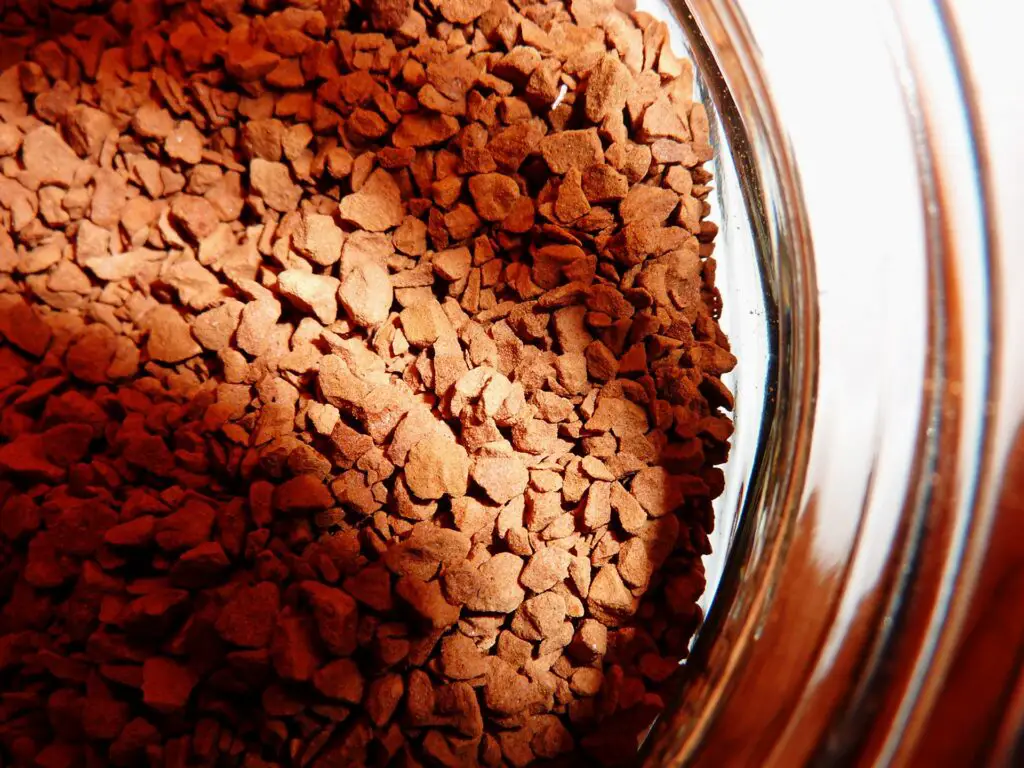
Instant coffee is the quickest and easiest way to get your caffeine fix while camping.
It’s lightweight and doesn’t require any equipment.
Just add hot water, stir, and you’re good to go.
- Pros: It’s incredibly fast and lightweight, making it perfect for ultralight backpackers and minimalists who don’t want to carry extra gear.
- Cons: The trade-off is in quality. Instant coffee generally lacks the rich flavor and aroma of freshly brewed coffee.
- Ideal for: Ultralight backpackers and minimalists who prioritize convenience and speed over coffee quality.
2. Cowboy Coffee
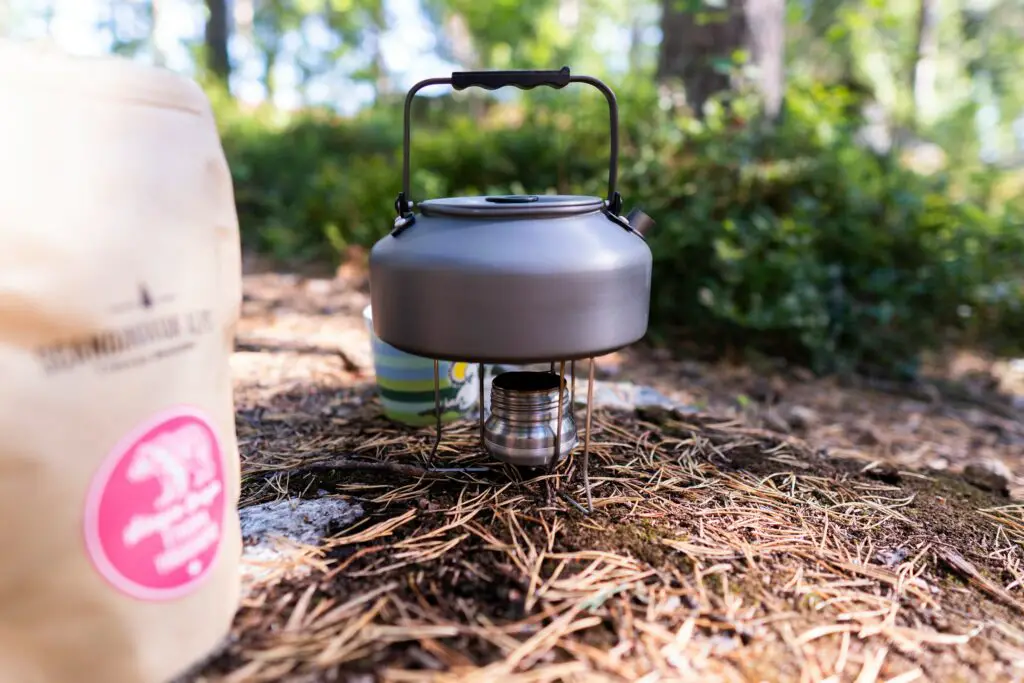
Cowboy coffee is one of the simplest methods to make coffee while camping.
Start by filling a kettle with cold water and bringing it to a near boil over your campfire or stove.
Once the water is hot, remove it from the heat and add your coarse coffee grounds.
Let the mixture sit for a few minutes, allowing the grounds to settle at the bottom.
- Pros: This method is straightforward and doesn’t require any special equipment. It’s perfect for those who prefer a rustic approach.
- Cons: Cowboy coffee can be gritty since the grounds settle in the bottom of the pot. This might not be ideal for everyone, but it’s part of the charm for many campers.
- Equipment: Kettle, coarse coffee grounds.
3. Coffee Steeping Bags
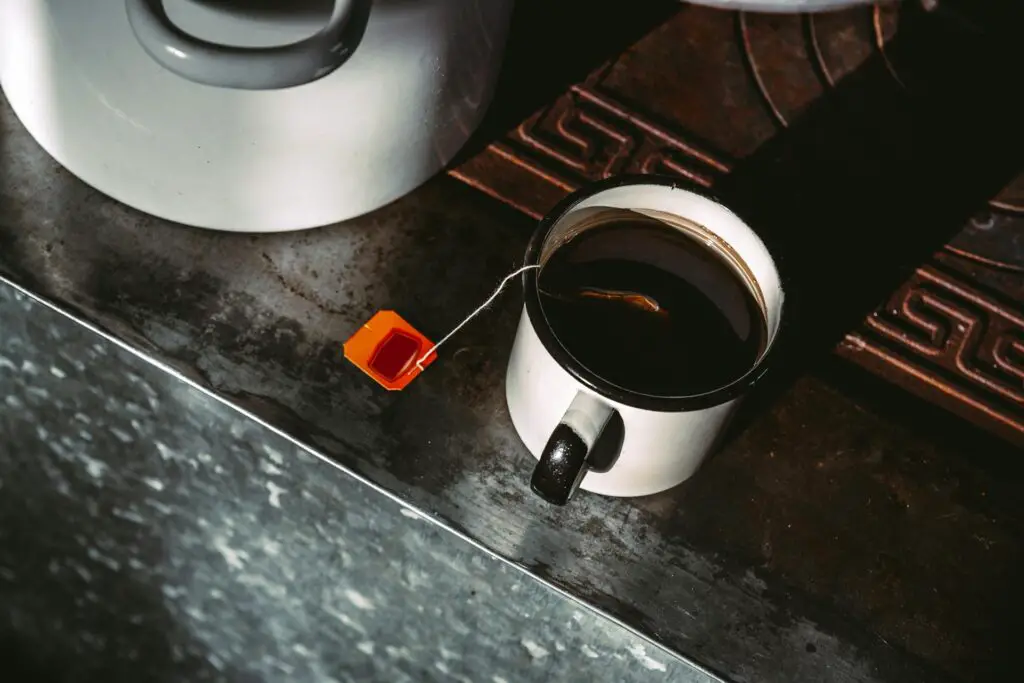
Using coffee steeping bags is incredibly simple.
Just like making tea, you place the coffee bag in your mug and pour hot water over it.
Let it steep for a few minutes, adjusting the time based on how strong you like your coffee.
- Pros: This method is very convenient and makes for easy cleanup. The used coffee bag can be disposed of quickly, making it ideal for camping.
- Cons: Coffee steeping bags are usually limited to single servings. This might not be the best option if you’re camping with a group and need to make multiple cups.
- Equipment: Coffee bags, hot water.
4. Pour Over Coffee
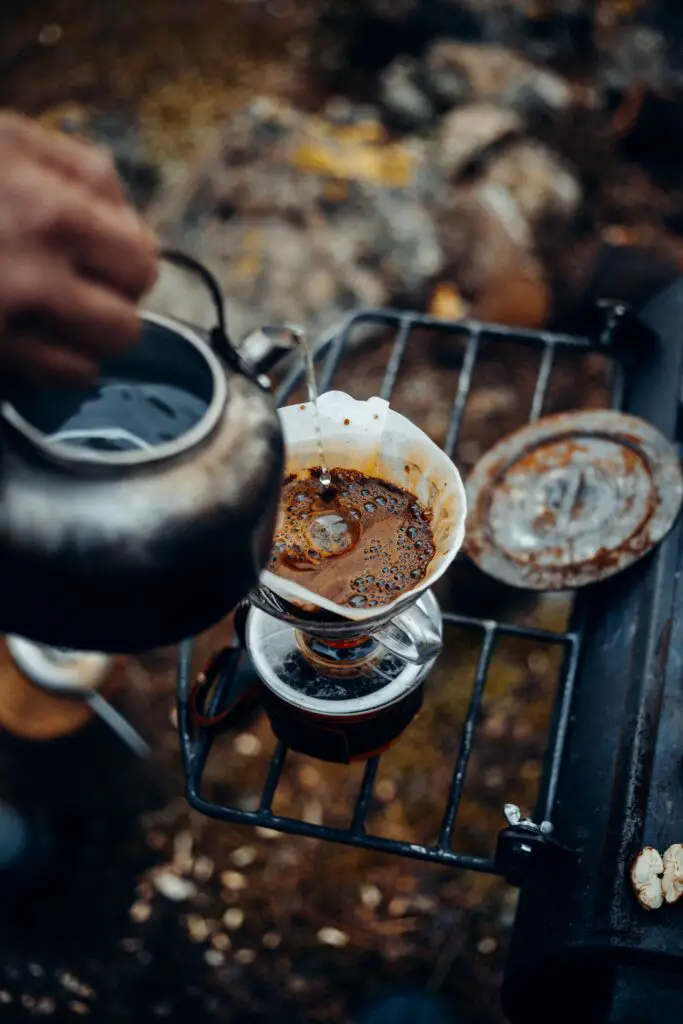
To make pour-over coffee, start by placing a filter in your coffee dripper and setting it over your mug.
Add your coffee grounds to the filter.
Slowly pour hot water over the grounds, using a circular motion.
Allow the water to pass through the coffee into your mug.
- Pros: This method offers high-quality coffee and gives you control over the brewing process, allowing for a more customized taste.
- Cons: It requires some equipment, which can add to your camping load.
- Recommended gear: Stanley Classic Perfect-Brew Pour Over.
- Equipment: Filter cone, coffee dripper, kettle.
5. AeroPress
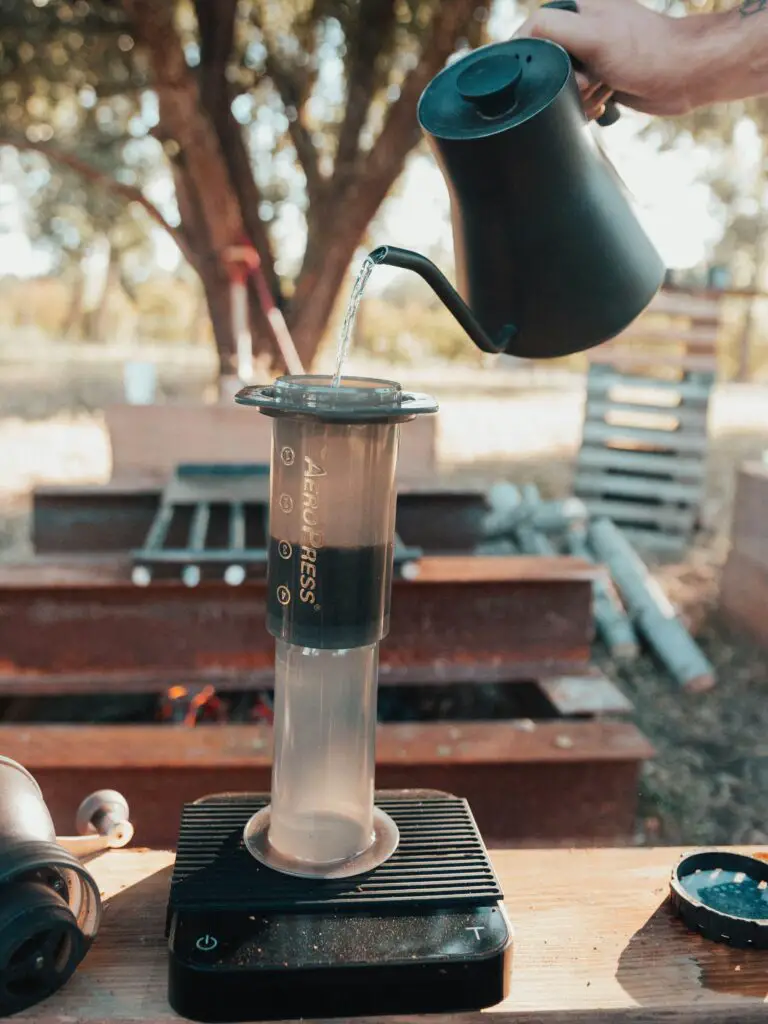
The AeroPress combines immersion and pressure to brew coffee.
Start by placing a filter in the AeroPress cap and attaching it to the chamber.
Add your coffee grounds, pour in hot water, stir, and let it steep for a few seconds.
Then, press the plunger down slowly to extract the coffee.
- Pros: This method is versatile and easy to clean. It allows you to adjust brewing time and pressure for different flavors.
- Cons: It requires specific filters, which means you need to bring extras.
- Recommended gear: AeroPress Go.
- Equipment: AeroPress, filters, hot water.
6. Moka Pot
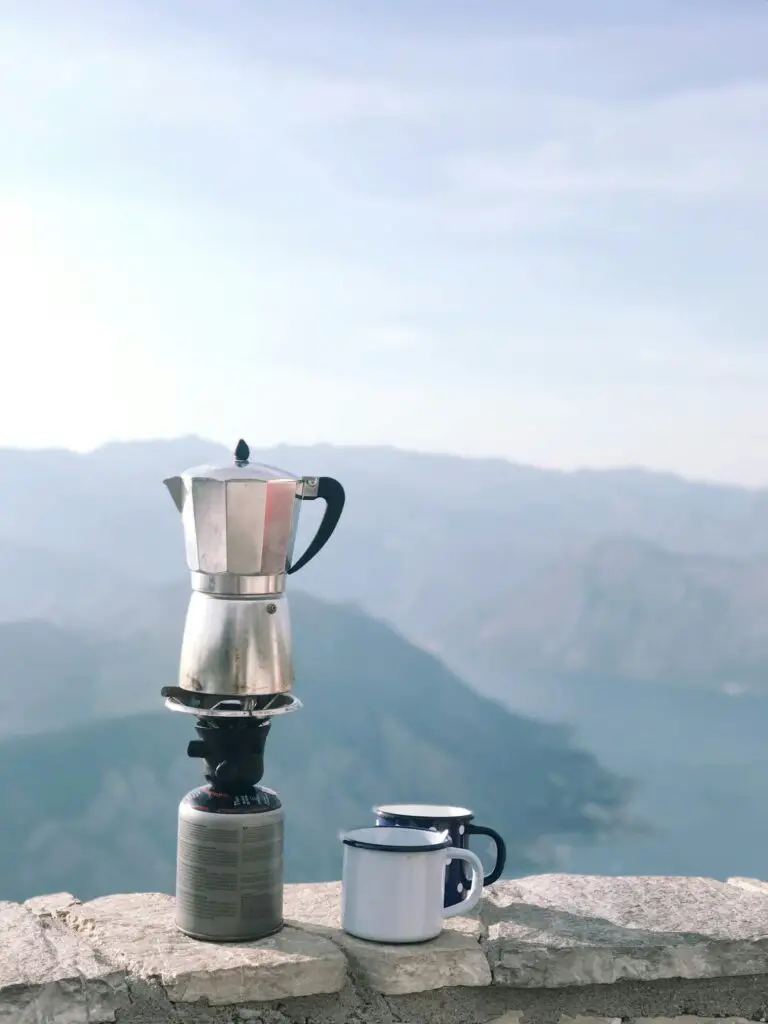
The Moka pot brews espresso-like coffee by boiling water through coffee grounds.
Fill the bottom chamber with water, add coffee grounds to the filter basket, and assemble the pot.
Place it on the stove and heat until the coffee starts to ooze into the top chamber.
- Pros: This method produces strong coffee with a robust flavor.
- Cons: The Moka pot is heavier and has more parts to clean compared to other methods.
- Recommended gear: Bialetti models.
- Equipment: Moka pot, stove.
7. French Press

To use a French press, add coarse coffee grounds and hot water.
Let the grounds steep for about four minutes.
Then, press the plunger down slowly and pour the coffee into your cup.
- Pros: This method delivers rich, full-bodied coffee.
- Cons: It can be bulkier than other methods and harder to clean.
- Recommended gear: GSI Outdoors JavaPress.
- Equipment: French press, coarse grounds.
8. Percolator
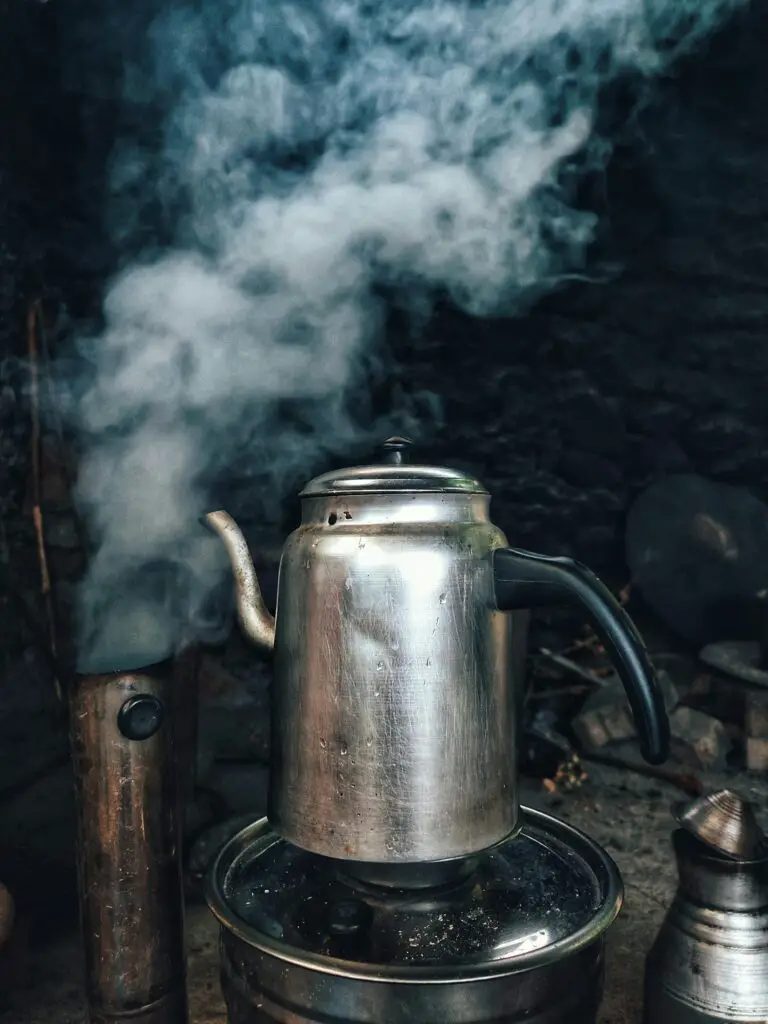
A percolator cycles boiling water through coffee grounds multiple times.
Fill the bottom chamber with water, add coffee grounds to the filter basket, and place it over heat.
The water will boil and repeatedly pass through the grounds, extracting coffee.
- Pros: This method can brew large quantities of coffee, making it ideal for groups.
- Cons: Percolators can easily over-extract coffee, leading to a bitter taste if not monitored carefully.
- Recommended gear: Coletti Classic Percolator.
- Equipment: Percolator, stove, or campfire.
9. Hand-Powered Espresso Makers
Use manual pressure to extract espresso.
Add finely ground coffee to the portafilter, pour hot water into the chamber, and apply pressure using the device’s pump.
- Pros: This method allows you to enjoy café-quality espresso anywhere, offering rich flavor and a satisfying crema.
- Cons: It requires more effort compared to other methods and may involve a bit of a learning curve.
- Recommended gear: Nanopresso and Handpresso are popular choices known for their durability and efficiency.
- Equipment: Hand-powered espresso maker.
10. Bripe Coffee Pipe
Fill the Bripe with finely ground coffee and water.
Heat the mixture using a butane lighter until it reaches the desired temperature, then sip directly from the pipe.
- Pros: The Bripe is ultra-portable and offers a unique brewing experience. It’s compact, making it ideal for minimalistic campers.
- Cons: It’s an unconventional method that may be slower than other brewing techniques and requires a bit of practice to master.
- Equipment: Bripe coffee pipe, butane lighter.
Cleanup Tips for Each Method
Keeping your coffee equipment clean while camping is essential for a good brew and environmental responsibility.
Here are simple methods for cleaning each type of brewing equipment.
- Instant Coffee: Dispose of the empty packet responsibly. No equipment to clean.
- Cowboy Coffee: Rinse the kettle with water after discarding the grounds.
- Coffee Steeping Bags: Dispose of the used bag properly. No equipment to clean.
- Pour Over: Discard the filter and grounds. Rinse the dripper with water.
- AeroPress: Eject the coffee puck and rinse all parts with water.
- Moka Pot: Disassemble, rinse each part with water, and dry thoroughly.
- French Press: Remove grounds, rinse the plunger and carafe with water.
- Percolator: Discard the grounds, rinse all parts with water, and dry thoroughly.
- Hand-Powered Espresso Makers: Disassemble, rinse all parts, and dry.
- Bripe Coffee Pipe: Rinse the pipe thoroughly and dry.
Emphasize “Leave No Trace” Principles
Always follow “Leave No Trace” principles by properly disposing of waste and minimizing impact on the environment.
Pack out all trash and be mindful of your surroundings to preserve nature for future campers.
Additional Tips
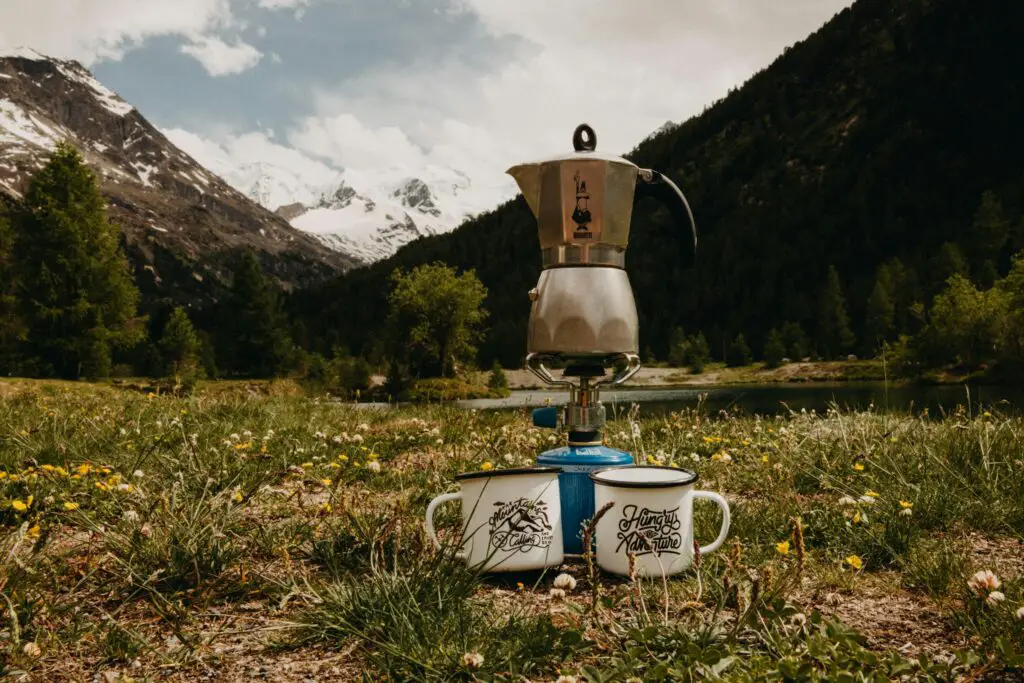
Using high-quality beans is crucial for a better flavor.
Fresh, high-quality beans can significantly enhance your coffee experience.
Grind your beans just before brewing to preserve their aroma and taste.
In addition to this, avoid boiling your coffee.
Instead, maintain an optimal brewing temperature between 200-205°F.
This range extracts the best flavors without making the coffee bitter.
Lastly, pack the right gear and be prepared.
Ensure you have all necessary equipment and supplies before heading out.
This includes coffee, a grinder (if using whole beans), a heat source, and your chosen brewing method.
Proper preparation ensures a smooth coffee-making process in the wilderness.
Sourcing Your Coffee
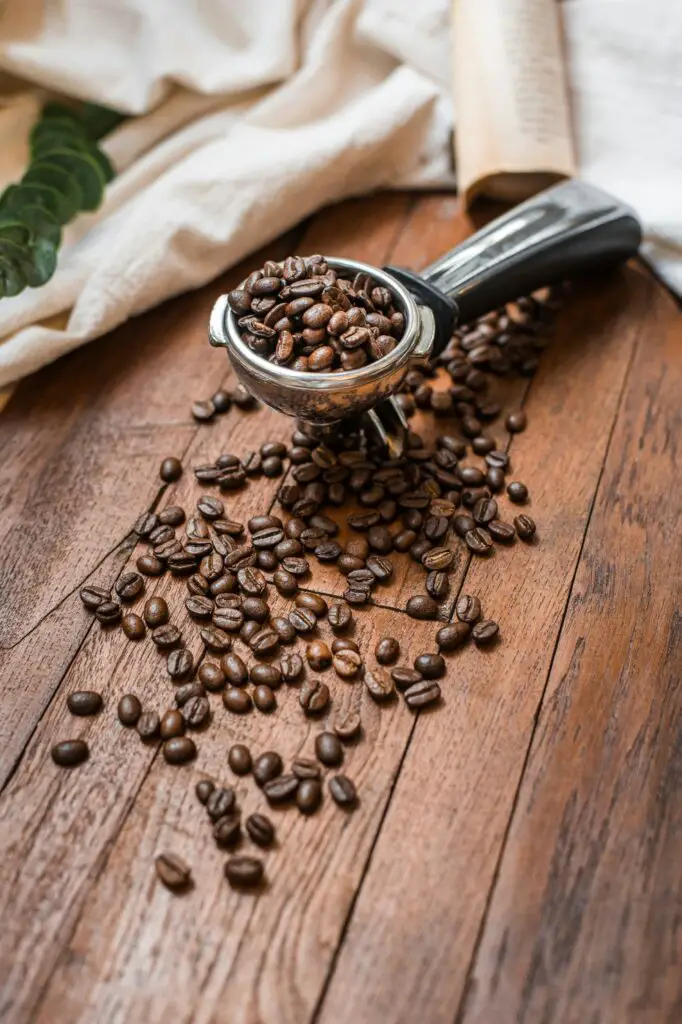
Pre-ground vs. Whole Beans
Pre-ground coffee offers convenience, making it a good choice for quick, hassle-free brewing.
It’s ideal when you want to save time and reduce the amount of gear you need to carry.
Whole beans, on the other hand, provide superior freshness.
By grinding the beans just before brewing, you can enjoy the fullest flavor and aroma.
This option requires a portable grinder but results in a noticeably better cup of coffee.
Local Coffee Recommendations
Consider supporting small, local coffee businesses.
They often offer fresh, high-quality roasts that can enhance your camping coffee experience.
Plus, buying local helps sustain your community and reduces the carbon footprint associated with larger coffee brands.
Conclusion
Brewing coffee outdoors is a simple pleasure that enhances any camping experience.
Each method offers its own unique benefits and can be tailored to your preferences.
Experiment with different techniques to find the one that suits you best.
Enjoy the process and the rich, flavorful results that come with brewing coffee in nature.
Happy camping!
